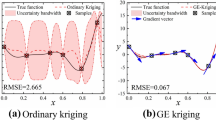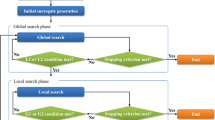Abstract
A computationally efficient surrogate model is suggested to approximate the objective and constraint function values, which replace expensive evaluation of the objective and constraint function values in numerical simulation-based optimization. Kriging surrogate model has been widely used in surrogate-based design optimization (SBDO) to replace the highly nonlinear black-box functions. In this paper, a novel adaptive Kriging model based on parallel infilling strategy is proposed to improve both the numerical accuracy and efficiency of the SBDO methods. The parallel infilling strategy consists of two parts: local sampling and globaluthor sampling. In the local sampling, new additional sampling points are generated only within a limited region that is determined according to the optimal point at the last iteration, while in global sampling they are generated based on the fitting error estimation in the whole region. The effectiveness of the proposed algorithm is verified through applications to analytical functions. Then the algorithm is applied to the multi-objective optimal design of an ironless permanent magnet synchronous linear motor.






Similar content being viewed by others
References
Hua GZ, Li L, Teng L et al (2012) Global optimization method using sle and adaptive rbf based on fuzzy clustering. Chin J Mech Eng Engl 25(4):768–775
Bahram C, Ehsan M, Mohammad G (2019) An ensemble prediction of flood susceptibility using multivariate discriminant analysis, classification and regression trees, and support vector machines. Sci Total Environ 651(2):2087–2096
Bin X, Gil-Gyun J, Chang-Seop K (2016) Kriging assisted PSO algorithm and its application to optimal transposition design of power transformer windings for the reduction of circulating current loss. IEEE Trans Magn 53(3):1–4
Wang L, Lowther DA (2006) Selection of approximation models for electromagnetic device optimization. IEEE Trans Magn 42(2):1227–1230
Luiz L, Rondini CA, Mauricio CC et al (2004) Kriging: a useful tool for electromagnetic device optimization. IEEE Trans Magn 40(2):1196–1199
Yao CJ (2011) Surrogate-assisted evolutionary computation: recent advances and future challenges. Swarm Evol Comput 1(2):61–70
Chao LS, Yao CJ, Ran C et al (2017) Surrogate-assisted cooperative swarm optimization of high-dimensional expensive problems. IEEE Trans Evol Comput 21(4):644–660
Wolfgang P, Tobias W, Markus V (2008) Clustered multiple generalized expected improvement: a novel infill sampling criterion for surrogate models. In: Proceedings of IEEE Congress on Evolutionary Computation, Hong Kong, China.
Jones DR (2001) A taxonomy of global optimization methods based on response surfaces. J Global Optim 21(4):345–383
Jones DR, Schonlau M, Welch WJ (1998) Efficient global optimization of expensive black-box functions. J Global Optim 13(4):445–492
Michael JS, Panos P, Pierre G (2002) Exploration of metamodeling sampling criteria for constrained global optimization. Eng Optim 34(3):263–278
Bin X, Minh-TP YLZ, Chang-Seop K (2013) A global optimization algorithm for electromagnetic devices by combining adaptive taylor kriging and particle swarm optimization. IEEE Trans Magn 49(5):2061–2064
Shao WL, Shi QZ, Xiao QT, Bao S (2013) Adaptive speed control based on just-in-time learning technique for permanent magnet synchronous linear motor. J Process Control 2(10):1455–1464
Sadegh V-Z, Hassanpour IA (2006) Multi objective design optimization of air-core linear permanent-magnet synchronous motors for improved thrust and low magnet consumption. IEEE Trans Magn 42(3):446–452
Song QS, Gary GW (2010) Survey of modeling and optimization strategies to solve high-dimensional design problems with computationally-expensive black-box functions. Struct Mutltidiscip Opt 41(2):219–241
Robert VH, Mckean JW, Craig AT (2005) Introduction to mathematical statistics: international edition. Pearson Education Press, London, pp 254–260
Forrester AIJ, Sobester A, Keane AJ (2008) Engineering design via surrogate modelling: a practical guide, DBLP. Wiley, New Jersey
Xiao L, Yun YY, Zhuo Z et al (2010) Magnetic field and thrust analysis of air-cored permanent linear servo motor. Zhejiang Daxue Xuebao (Gongxue Ban) 3(3):533–538
Funding
This research was supported by Basic Science Research Program through the National Research Foundation of Korea (NRF) funded by the Ministry of Education (grant number 2020R1I1A3A04037180).
Author information
Authors and Affiliations
Corresponding author
Additional information
Publisher's Note
Springer Nature remains neutral with regard to jurisdictional claims in published maps and institutional affiliations.
Rights and permissions
About this article
Cite this article
Xia, B., Liu, R., He, Z. et al. A Single- and Multi-objective Optimization Algorithm for Electromagnetic Devices Assisted by Adaptive Kriging Based on Parallel Infilling Strategy. J. Electr. Eng. Technol. 16, 301–308 (2021). https://doi.org/10.1007/s42835-020-00558-8
Received:
Revised:
Accepted:
Published:
Issue Date:
DOI: https://doi.org/10.1007/s42835-020-00558-8




